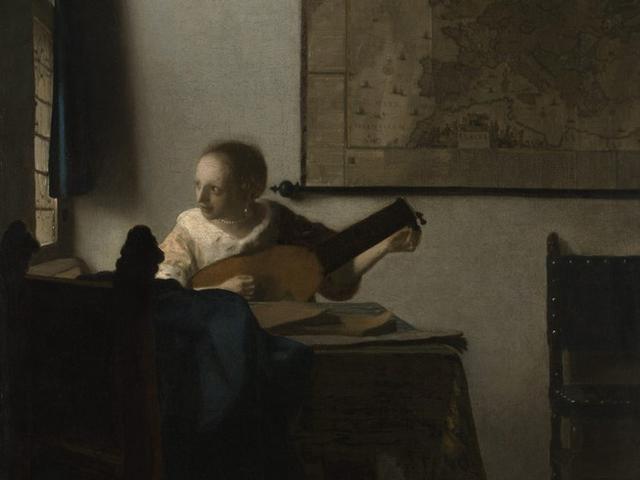Woman with a lute

One of Vermeer's beloved "pearl pictures," Woman with a Lute, evokes expectations, longings, and perhaps even conscious moderation or temperance, all in a mere 20 x 18 inches. Familiar objects, such as the extraordinary pearl drop earring that catches the sunlight, the lion's head-finish chair, the map of Europe, and the yellow ermine-trimmed jacket, are placed with care and precision in this tranquil interior scene. .
There is no doubt that this charming musician is the focal point; the large map, the towering lion heads, and the blue curtains of the lead window frame his face, and especially those misty eyes. Vermeer's muted tones and gossamer shadows capture a moment in which we can imagine the music pausing long enough for this anticipatory young woman to tune her instrument and perhaps catch her first glimpse of the object of her desire. The score and the silent viola da gamba in the middle foreground point to a pending duet, as does its aspect of longing and desire. The map of Europe, however, dotted with sailing ships, perhaps a subtle suggestion that their wait, and the duo themselves, may be a little delayed.
As a renowned Dutch artist during the Golden Age era, Johannes Vermeer made a name for himself with his famous works, such as View of Delft and Little Street. Perhaps, this was all due to the fact that he was born in Delft, in the Netherlands. Therefore, his inspirations mainly came from where he grew up, which had a great impact on his life and career as a painter. His other paintings include The Concert, Women with a Jug of Water, and Girl Asleep at the Table. These were his popular masterpieces as his style evolved after his experience as part of the Delft Painters' Guild in his hometown.
From the early 19th century through the 20th century, Woman with a Lute was in the collection of millionaire railroad developer Collis P. Huntington, who bequeathed it along with many other paintings to the Metropolitan Museum of Art. His second wife, Arabella, and his son, Archer, received a vital interest in painting, but he moved to the Met in 1925, a year after Arabella's death. Other paintings from Arabella's collection now reside at Norton Simon's neighboring institution, the Huntington Library, Art Collections and Botanical Gardens in San Marino, which was formed by Arabella and her later husband Henry E. Huntington, Collis' nephew.
© Tourblink